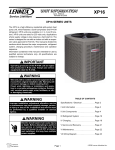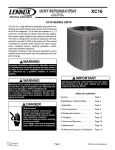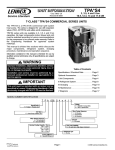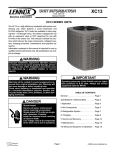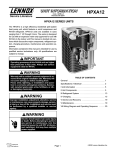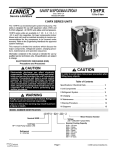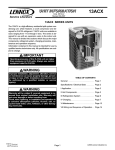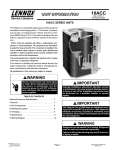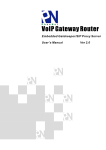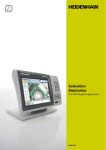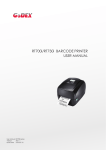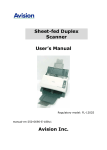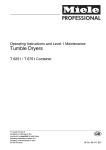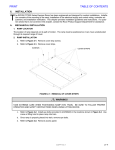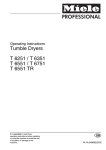Download XP13 Series - HvacPartsShop.com
Transcript
Service Literature Corp. 0528−L10 Revised 05−2008 XP13 XP13 SERIES UNITS The XP13 is a high efficiency residential split−system heat pump unit, which features a scroll compressor and R−410A refrigerant. XP13 units are available in sizes ranging from 1 1/2 through 5 tons. The series is designed for use with an indoor unit with an expansion valve approved for R−410A. This manual is divided into sections which discuss the major components, refrigerant system, charging procedure, maintenance and operation sequence. Information contained in this manual is intended for use by qualified service technicians only. All specifications are subject to change. IMPORTANT Operating pressures of this R−410A unit are higher than pressures in R−22 units. Always use service equipment rated for R−410A. WARNING Warranty will be voided if covered equipment is removed from original installation site. Warranty will not cover damage or defect resulting from: Flood, wind, lightning, or installation and operation in a corrosive atmosphere (chlorine, fluorine, salt, recycled waste water, urine, fertilizers, or other damaging chemicals). WARNING TABLE OF CONTENTS Improper installation, adjustment, alteration, service or maintenance can cause property damage, personal injury or loss of life. Installation and service must be performed by a qualified installer or service agency. Specifications / Electrical . . . . . . . . . . . . . Page 2 I Unit Information . . . . . . . . . . . . . . . . . . . . Page 3 II Unit Components . . . . . . . . . . . . . . . . . . Page 3 III Refrigerant System . . . . . . . . . . . . . . . . Page 8 WARNING IV Charging . . . . . . . . . . . . . . . . . . . . . . . . . Page 10 Electric shock hazard. Can cause injury or death. Before attempting to perform any service or maintenance, turn the electrical power to unit OFF at disconnect switch(es). Unit may have multiple power supplies. Page 1 V Service and Recovery . . . . . . . . . . . . . . Page 13 VI Maintenance . . . . . . . . . . . . . . . . . . . . . . Page 14 VII Brazing Procedure . . . . . . . . . . . . . . . . Page 14 VIII Wiring Diagram . . . . . . . . . . . . . . . . . . Page 15 ©2005 Lennox Industries Inc. SPECIFICATIONS General D t Data Connections ( t) (sweat) Refrigerant Outdoor C il Coil Model No. XP13−018 XP13−024 XP13−030 XP13−036 XP13−037 XP13−042 XP13−048 XP13−060 2 2.5 3 3+ 3.5 4 5 Nominal Tonnage 1.5 Liquid line (o.d.) − in. 3/8 3/8 3/8 3/8 3/8 3/8 3/8 3/8 Vapor line (o.d.) 3/4 3/4 3/4 3/4 3/4 7/8 7/8 1−1/8 1 R−410A charge furnished 8 lbs. 7 lbs. 7 lbs. 10 lbs. 10 lbs. 11 lbs. 11 lbs. 15 lbs. 15 oz. 7 oz. 10 oz. 2 oz. 3 oz. 10 oz. 10 oz. 0 oz. Net face area sq. ft ft. Outer coil Inner coil Tube diameter − in. No. of Rows Fins per inch Outdoor Diameter − in. F Fan No. of blades Motor hp Cfm Rpm Watts Shipping Data − lbs. 1 pkg. 13.22 12.65 5/16 2 22 18 3 1/10 2215 1040 145 189 13.22 12.65 5/16 2 22 18 3 1/10 2215 1040 145 188 13.22 12.65 5/16 2 22 18 3 1/10 2270 1050 165 192 15.11 14.46 5/16 2 22 18 3 1/10 2330 1060 170 208 18.67 18.00 5/16 2 22 22 4 1/6 3150 844 215 235 18.67 18.00 5/16 2 22 22 4 1/6 3150 844 215 260 18.67 18.00 5/16 2 22 22 4 1/4 3730 824 320 267 24.50 23.64 5/16 2 22 22 4 1/4 3980 836 305 305 ELECTRICAL DATA Line voltage data − 60hz − 1 phase 208/230V 208/230V 208/230V 208/230V 208/230V 208/230V 208/230V 208/230V overcurrent protection (amps) 20 30 30 35 35 40 50 60 2 Minimum circuit ampacity 11.9 17.5 18.4 21.6 21.9 23.2 28.9 34.6 Compressor p Rated load amps 8.97 13.46 14.1 16.67 16.67 17.69 21.79 26.28 Locked rotor amps 48 58 73 79 79 107 117 134 Power factor 0.98 0.98 0.98 0.99 0.99 0.99 0.99 0.99 Outdoor Fan Full load amps 0.7 0.7 0.7 0.7 1.1 1.1 1.7 1.7 M t Motor Locked Rotor Amps 1.4 1.4 1.4 1.4 2.1 2.1 2.1 3.1 3 Maximum OPTIONAL ACCESSORIES − must be ordered extra Compressor p Hard Start Kit Compressor Crankcase Heater Compressor Low Ambient Cut−Off Compressor Sound Cover Freezestat 3/8 in. tubing 5/8 in. tubing Low Ambient Kit Low Pressure Switch Bypass Thermostat 10J42 88M91 93M04 45F08 69J03 93G35 50A93 54M89 13W07 Mild Weather Kit 33M07 Monitor Kit − Service Light 76F53 Outdoor Thermostat 56A87 Th t t Kit Thermostat Mounting Box 31461 Refrigerant L15−41−20 L15−41−40 Line Sets L15−41−30 L15−41−50 L15−65−30 Time Delay Relay Factory L15−65−40 L15−65−50 Field Fabricate 58M81 NOTE − Extremes of operating range are plus 10% and minus 5% of line voltage. 1 Refrigerant charge sufficient for 15 ft. length of refrigerant lines. 2 Refer to National or Canadian Electrical Code manual to determine wire, fuse and disconnect size requirements. 3 HACR type breaker or fuse. Page 2 I − UNIT INFORMATION A − Control Box (Figure 2) XP13 units are not equipped with a 24V transformer. All 24 VAC controls are powered by the indoor unit. Refer to wiring diagram. ELECTROSTATIC DISCHARGE (ESD) Precautions and Procedures CAUTION SINGLE PHASE UNIT CONTROL BOX Electrostatic discharge can affect electronic components. Take precautions during unit installation and service to protect the unit’s electronic controls. Precautions will help to avoid control exposure to electrostatic discharge by putting the unit, the control and the technician at the same electrostatic potential. Neutralize electrostatic charge by touching hand and all tools on an unpainted unit surface before performing any service procedure. DUAL CAPACITOR (C12) COMPRESSOR CONTACTOR (K1) All major components (indoor blower and coil) must be matched according to Lennox recommendations for the compressor to be covered under warranty. Refer to the Engineering Handbook for approved system matchups. A misapplied system will cause erratic operation and can result in early compressor failure. IMPORTANT This unit must be matched with an indoor coil as specified in Lennox’ Engineering Handbook. DEFROST CONTROL (A108) GROUNDING LUG FIGURE 2 Electrical openings are provided under the control box cover. Field thermostat wiring is made to a 24V terminal strip located on the defrost control board located in the control box. See figure 3. 24V THERMOSTAT TERMINAL STRIP II − UNIT COMPONENTS Unit components are illustrated in figure 1. XP13 UNIT COMPONENTS OUTDOOR FAN Y1 O COMPRESSOR R L C W1 FIGURE 3 1 − Compressor Contactor K1 CONTROL BOX EXPANSION VALVE DANGER FILTER DRIER Electric Shock Hazard. May cause injury or death. Line voltage is present at all components when unit is not in operation on units with single pole contactors. Disconnect all remote electrical power supplies before opening unit panel. Unit may have multiple power supplies. REVERSING VALVE HIGH PRESSURE SWITCH LIQUID LINE SERVICE VALVE The compressor is energized by a contactor located in the control box. See figure 2. Single−pole contactors are used in all XP13 series units. K1 is energized through the control board by the indoor thermostat terminal Y1 (24V) when thermostat demand is present. VAPOR LINE SERVICE VALVE FIGURE 1 Page 3 2 − Dual Capacitor C12 The compressor and fan in XP13 series units use permanent split capacitor motors. The capacitor is located inside the unit control box (see figure 2). A single dual" capacitor (C12) is used for both the fan motor and the compressor (see unit wiring diagram). The fan side and the compressor side of the capacitor have different MFD ratings. See side of capacitor for ratings. 3 − Defrost Control The XP13 defrost system includes two components: a defrost thermostat and a defrost control. Defrost Thermostat (Defrost Switch S6) The defrost thermostat is located on the liquid line between the check/expansion valve and the distributor. When defrost thermostat senses 42°F (5.5°C) or cooler, the thermostat contacts close and send a signal to the defrost control board to start the defrost timing. It also terminates defrost when the liquid line warms up to 70°F (21°C). Defrost Control The defrost control board includes the combined functions of a time/temperature defrost control, defrost relay, diagnostic LEDs and terminal strip for field wiring connections. The control provides automatic switching from normal heating operation to defrost mode and back. During compressor cycle (call for defrost), the control accumulates compressor run times at 30-, 60-, or 90-minute field−adjustable intervals. If the defrost thermostat is closed when the selected compressor run time interval ends, the defrost relay is energized and defrost begins. XP13 Outdoor Unit Defrost Control Board FIELD SELECT TIMING PINS TEST PINS DIAGNOSTIC LEDS COMPRESSOR DELAY PINS REVERSING VALVE 24V TERMINAL STRIP CONNECTIONS S87 LOW PRESSURE SWITCH DEFROST THERMOSTAT S4 HIGH PRESSURE SWITCH FIGURE 4 Defrost Control Timing Pins Each timing pin selection provides a different accumulated compressor run time period for one defrost cycle. This time period must occur before a defrost cycle is initiated. The defrost interval can be adjusted to 30, 60 or 90 minutes (see figure 4). The defrost timing jumper is facto- ry−installed to provide a 60−minute defrost interval. If the timing selector jumper is not in place, the control defaults to a 90−minute defrost interval. The maximum defrost period is 14 minutes and cannot be adjusted. A TEST option is provided for troubleshooting. The TEST mode may be started any time the unit is in the heating mode and the defrost thermostat is closed or jumpered. If the jumper is in the TEST position at power-up, the control will ignore the test pins. When the jumper is placed across the TEST pins for two seconds, the control will enter the defrost mode. If the jumper is removed before an additional 5−second period has elapsed (7 seconds total), the unit will remain in defrost mode until the defrost thermostat opens or 14 minutes have passed. If the jumper is not removed until after the additional 5−second period has elapsed, the defrost will terminate and the test option will not function again until the jumper is removed and re−applied. Compressor Delay The defrost board has a field−selectable function to reduce occasional sounds that may occur while the unit is cycling in and out of the defrost mode. The compressor will be cycled off for 30 seconds going in and out of the defrost mode when the compressor delay jumper is removed. NOTE − The 30-second compressor feature is ignored when the defrost test pins are jumpered. Time Delay The timed-off delay is five minutes long. The delay helps to protect the compressor from short-cycling in case the power to the unit is interrupted or a pressure switch opens. The delay is bypassed by placing the timer select jumper across the TEST pins for 0.5 seconds. Pressure Switch Circuit The defrost control incorporates two pressure switch circuits. The high pressure switch (S4) is factory-connected to the board’s HI PS terminals (see figure 4). The board also includes a low pressure, or loss-of-charge-pressure, switch (S87). Switches are shown in the unit wiring diagram. During a single demand cycle, the defrost control will lock out the unit after the fifth time that the circuit is interrupted by any pressure switch wired to the control board. In addition, the diagnostic LEDs will indicate a locked-out pressure switch after the fifth occurrence of an open pressure switch (see Table 1). The unit will remain locked out until power to the board is interrupted, then re-established or until the jumper is applied to the TEST pins for 0.5 seconds. Some XP13 units will be equipped with an optional by−pass switch wired in parallel with the low pressure switch (S87). This by−pass switch prevents nuisance trips when ambient conditions drop below 15° F. NOTE − The defrost control board ignores input from the low-pressure switch terminals as follows: during the TEST mode, during the defrost cycle, during the 90-second start-up period, and for the first 90 seconds each time the reversing valve switches heat/cool modes. Diagnostic LEDs The defrost board uses two LEDs for diagnostics. The LEDs flash a specific sequence according to the condition. Page 4 TABLE 1 SCROLL FORM Defrost Control Board Diagnostic LED Mode No power to control Green LED (DS2) Red LED (DS1) OFF OFF Normal operation / power to control Simultaneous Slow FLASH Anti-short cycle lockout FIGURE 6 Alternating Slow FLASH Low pressure switch fault OFF Low pressure switch lockout OFF ON High pressure switch fault Slow FLASH OFF High pressure switch lockout ON OFF CROSS−SECTION OF SCROLLS Slow FLASH DISCHARGE DISCHARGE PRESSURE STATIONARY SCROLL SUCTION B − Compressor The scroll compressors in all XP13 model units are designed for use with R−410A refrigerant and operation at high pressures. Compressors are shipped from the factory with 3MA (32MMMA) P.O.E. oil. See electrical section in this manual for compressor specifications. The scroll compressor design is simple, efficient and requires few moving parts. A cutaway diagram of the scroll compressor is shown in figure 5. The scrolls are located in the top of the compressor can and the motor is located just below. The oil level is immediately below the motor. The scroll is a simple compression concept centered around the unique spiral shape of the scroll and its inherent properties. Figure 6 shows the basic scroll form. Two identical scrolls are mated together forming concentric spiral shapes (figure 7). One scroll remains stationary, while the other is allowed to "orbit" (figure 8). Note that the orbiting scroll does not rotate or turn but merely orbits the stationary scroll. SCROLL COMPRESSOR DISCHARGE SUCTION FIGURE 5 NOTE − During operation, the head of a scroll compressor may be hot since it is in constant contact with discharge gas. Page 5 TIPS SEALED BY DISCHARGE PRESSURE ORBITING SCROLL FIGURE 7 The counterclockwise orbiting scroll draws gas into the outer crescent shaped gas pocket created by the two scrolls (figure 8 − 1). The centrifugal action of the orbiting scroll seals off the flanks of the scrolls (figure 8 − 2). As the orbiting motion continues, the gas is forced toward the center of the scroll and the gas pocket becomes compressed (figure 8 − 3). When the compressed gas reaches the center, it is discharged vertically into a chamber and discharge port in the top of the compressor (figure 7). The discharge pressure forcing down on the top scroll helps seal off the upper and lower edges (tips) of the scrolls (figure 7). During a single orbit, several pockets of gas are compressed simultaneously providing smooth continuous compression. The scroll compressor is tolerant to the effects of liquid return. If liquid enters the scrolls, the orbiting scroll is allowed to separate from the stationary scroll. The liquid is worked toward the center of the scroll and is discharged. If the compressor is replaced, conventional Lennox cleanup practices must be used. Due to its efficiency, the scroll compressor is capable of drawing a much deeper vacuum than reciprocating compressors. Deep vacuum operation can cause internal fusite arcing resulting in damaged internal parts and will result in compressor failure. Never use a scroll compressor for evacuating or pumping−down" the system. This type of damage can be detected and will result in denial of warranty claims. The scroll compressor is quieter than a reciprocating compressor, however, the two compressors have much different sound characteristics. The sounds made by a scroll compressor do not affect system reliability, performance, or indicate damage. SUCTION SUCTION 1 INTERMEDIATE PRESSURE GAS 2 ORBITING SCROLL CRESCENT SHAPED GAS POCKET STATIONARY SCROLL SUCTION POCKET FLANKS SEALED BY CENTRIFUGAL FORCE SUCTION SUCTION MOVEMENT OF ORBIT 3 4 HIGH PRESSURE GAS DISCHARGE POCKET FIGURE 8 C − Outdoor Fan Motor Remove screws All units use single−phase PSC fan motors which require a run capacitor. In all units, the condenser fan is controlled by the compressor contactor. ELECTRICAL DATA tables in this manual show specifications for condenser fans used in XP13’s. Access to the condenser fan motor on all units is gained by removing the four screws securing the fan assembly. See figure 9. The grill fan assembly can be removed from the cabinet as one piece. See figure 10. The condenser fan motor is removed from the fan guard by removing the four nuts found on top of the grill. See figure 10 if condenser fan motor replacement is necessary. Remove screws FIGURE 9 DANGER Make sure all power is disconnected before beginning electrical service procedures. NUTS (4) ALIGN FAN HUB FLUSH WITH END OF SHAFT FIGURE 10 D − Reversing Valve L1 and Solenoid A refrigerant reversing valve with electromechanical solenoid is used to reverse refrigerant flow during unit operation. The reversing valve requires no maintenance. It is not repairable. If the reversing valve has failed, it must be replaced. Page 6 E − Drier F − High/Low Pressure Switch A filter drier designed for all XP13 model units is factory installed in the liquid line. The filter drier is designed to remove moisture and foreign matter, which can lead to compressor failure. Moisture and / or Acid Check Because POE oils absorb moisture, the dryness of the system must be verified any time the refrigerant system is exposed to open air. A compressor oil sample must be taken to determine if excessive moisture has been introduced to the oil. Table 2 lists kits available from Lennox to check POE oils. If oil sample taken from a system that has been exposed to open air does not test in the dry color range, the filter drier MUST be replace. IMPORTANT Replacement filter drier MUST be approved for R−410A refrigerant and POE application. Foreign Matter Check It is recommended that a liquid line filter drier be replaced when the pressure drop across the filter drier is greater than 4 psig. To safeguard against moisture entering the system follow the steps in section IV − sub section B − "Evacuating the System" when replacing the drier. IMPORTANT Pressure switch settings for R−410A refrigerant will be significantly higher than units with R−22. An auto-reset, single-pole/single-throw high pressure switch is located in the liquid line. This switch shuts off the compressor when liquid line pressure rises above the factory setting. The switch is normally closed and is permanently adjusted to trip (open) at 590 + 15 psi. An auto-reset, single-pole/single-throw low pressure switch is located in the suction line. This switch shuts off the compressor when suction pressure drops below the factory setting. The switch is closed during normal operating pressure conditions and is permanently adjusted to trip (open) at 25 + 5 psi. The switch automatically resets when suction line pressure rises above 40 + 5 psi. Under certain conditions the low pressure switch is ignored. See Pressure Switch Circuit in the Defrost Control description. G − Crankcase Heater Crankcase heater prevents migration of liquid refrigerant into compressor and ensures proper compressor lubrication. The heaters are standard on the XP−037, −042, −048 and −060 and an option for all other models. TABLE 2 KIT CONTENTS TUBE SHELF LIFE 10N46 − Refrigerant Analysis Checkmate−RT700 10N45 − Acid Test Tubes Checkmate−RT750A (three pack) 2 − 3 years @ room temperature. 3+ years refrigerated 10N44 − Moisture Test Tubes Checkmate − RT751 Tubes (three pack) 6 − 12 months @ room temperature. 2 years refrigerated 74N40 − Easy Oil Test Tubes Checkmate − RT752C Tubes (three pack) 2 − 3 years @ room temperature. 3+ years refrigerated 74N39 − Acid Test Kit Sporian One Shot − TA−1 Page 7 III − REFRIGERANT SYSTEM Refer to figure 11 and 12 for refrigerant flow in the heating and cooling modes. The reversing valve is energized during cooling demand and during defrost. XP13 COOLING CYCLE (SHOWING MANIFOLD GAUGE CONNECTIONS) OUTDOOR UNIT DISTRIBUTOR COIL SENSOR REVERSING VALVE EXPANSION/CHECK VALVE LOW PRESSURE HIGH PRESSURE BIFLOW FILTER / DRIER OUTDOOR COIL INTERNAL COMPRESSOR LIMIT INDOOR UNIT MUFFLER GAUGE MANIFOLD TO R−410A DRUM SUCTION SERVICE PORT LIQUID LINE SERVICE PORT VAPOR LINE VALVE COMPRESSOR EXPANSION/CHECK VALVE INDOOR COIL NOTE − ARROWS INDICATE DIRECTION OF REFRIGERANT FLOW FIGURE 11 XP13 HEATING CYCLE (SHOWING MANIFOLD GAUGE CONNECTIONS) OUTDOOR UNIT DISTRIBUTOR COIL SENSOR REVERSING VALVE EXPANSION/CHECK VALVE LOW PRESSURE HIGH PRESSURE BIFLOW FILTER / DRIER OUTDOOR COIL INTERNAL COMPRESSOR LIMIT INDOOR UNIT MUFFLER GAUGE MANIFOLD TO R−410A DRUM LIQUID LINE SERVICE PORT SUCTION SERVICE PORT VAPOR LINE VALVE COMPRESSOR EXPANSION/CHECK VALVE NOTE − ARROWS INDICATE DIRECTION OF REFRIGERANT FLOW FIGURE 12 Page 8 INDOOR COIL A − Plumbing Field refrigerant piping consists of liquid and vapor lines from the outdoor unit (sweat connections). Use Lennox L15 (sweat) series line sets as shown in table 3. TABLE 3 Refrigerant Line Sets Field Connections To Close Service Valve: 1 − Remove the stem cap with an adjustable wrench. 2 − Use a service wrench with a hex−head extension to turn the stem clockwise to seat the valve. Tighten the stem firmly. NOTE − Use a 3/16" hex head extension for 3/8" line sizes or a 5/16" extension for large line sizes. Recommended Line Set Mod- Liquid Line el Vapor Line Liquid Line Vapor Line L15 Line Sets −018 −024 −030 −036 3/4 in (19 mm) 3/8 in. (10 mm) 3/4 in (19 mm) L15−41 15 ft. − 50 ft. (4.6 m − 15 m) 3/8 in. (10 mm) 3 − Replace the stem cap. Tighten finger tight, then tighten an additional 1/6 turn. −037 −042 −048 3/8 in. (10 mm) 7/8 in (22 mm) 3/8 in. (10 mm) 7/8 in (22 mm) L15−65 15 ft. − 50 ft. (4.6 m − 15 m) −060 3/8 in. (10 mm) 1−1/8 in. (29 mm) 3/8 in. (10 mm) 1−1/8 in. (29 mm) Field Fabricated 3 − Replace the stem cap. Tighten finger tight, then tighten an additional 1/6 turn. Service Valve (Valve Closed) stem cap service port B − Service Valves insert hex wrench here to outdoor coil IMPORTANT service port cap Only use Allen wrenches of sufficient hardness (50Rc − Rockwell Harness Scale min). Fully insert the wrench into the valve stem recess. Service valve stems are factory torqued (from 9 ft lbs for small valves, to 25 ft lbs for large valves) to prevent refrigerant loss during shipping and handling. Using an Allen wrench rated at less than 50Rc risks rounding or breaking off the wrench, or stripping the valve stem recess. to indoor coil Schrader valve open to line set when valve is closed (front seated) (valve front seated) insert hex wrench here Service valves (figures 13 and 14) and gauge ports are accessible from the outside of the unit. Use the service ports for leak testing, evacuating, charging and checking charge. Each valve is equipped with a service port which has a factory−installed Schrader valve. A service port cap protects the Schrader valve from contamination and serves as the primary leak seal. Service Valve (Valve Open) stem cap service port to outdoor coil To Access Schrader Port: 1 − Remove service port cap with an adjustable wrench. 2 − Connect gauge to the service port. 3 − When testing is complete, replace service port cap. Tighten finger tight, then an additional 1/6 turn. To Open Service Valve: 1 − Remove the stem cap with an adjustable wrench. 2 − Use a service wrench with a hex−head extension to back the stem out counterclockwise as far as it will go. NOTE − Use a 3/16" hex head extension for 3/8" line sizes or a 5/16" extension for large line sizes. Page 9 service port cap to indoor coil Schrader valve FIGURE 13 Vapor Line Ball Valve – 5 Ton Only Vapor line service valves function the same way as the other valves, the difference is in the construction. If a valve has failed, you must replace it. A ball valve is illustrated in figure 14. The ball valve is equipped with a service port with a factory− installed Schrader valve. A service port cap protects the Schrader valve from contamination and assures a leak−free seal. WARNING Danger of explosion! When using a high pressure gas such as dry nitrogen to pressurize a refrigerant or air conditioning system, use a regulator that can control the pressure down to 1 or 2 psig (6.9 to 13.8 kPa). Ball Valve (Valve Open) Use Adjustable Wrench To open: rotate Stem Clockwise 90°. To close: rotate Stem Counter-clockwise 90°. stem cap to outdoor coil Using an Electronic Leak Detector or Halide stem ball (shown open) to indoor coil service port cap service port Schrader valve FIGURE 14 IV − CHARGING A − Leak Testing After the line set has been connected to the indoor and outdoor units, check the line set connections and indoor unit for leaks. WARNING Refrigerant can be harmful if it is inhaled. Refrigerant must be used and recovered responsibly. Failure to follow this warning may result in personal injury or death. 1 − Connect a cylinder of R−410A to the center port of the manifold gauge set. 2 − With both manifold valves closed, open the valve on the R−410A cylinder (vapor only). 3 − Open the high pressure side of the manifold to allow the R−410A into the line set and indoor unit. Weigh in a trace amount of R−410A. [A trace amount is a maximum of 2 ounces (57 g) or 3 pounds (31 kPa) pressure.] Close the valve on the R−410A cylinder and the valve on the high pressure side of the manifold gauge set. Disconnect the R−410A cylinder. 4 − Connect a cylinder of nitrogen with a pressure regulating valve to the center port of the manifold gauge set. 5 − Connect the manifold gauge set high pressure hose to the vapor valve service port. (Normally, the high pressure hose is connected to the liquid line port; however, connecting it to the vapor port better protects the manifold gauge set from high pressure damage.) 6 − Adjust the nitrogen pressure to 150 psig (1034 kPa). Open the valve on the high side of the manifold gauge set which will pressurize line set and indoor unit. 7 − After a few minutes, open a refrigerant port to ensure the refrigerant you added is adequate to be detected. (Amounts of refrigerant will vary with line lengths.) Check all joints for leaks. Purge nitrogen and R−410A mixture. Correct any leaks and recheck. B − Evacuating the System WARNING Fire, Explosion and Personal Safety Hazard. Failure to follow this warning could result in damage, personal injury or death. Never use oxygen to pressurize or purge refrigeration lines. Oxygen, when exposed to a spark or open flame, can cause damage by fire and / or an explosion, that can result in personal injury or death. Evacuating the system of noncondensables is critical for proper operation of the unit. Noncondensables are defined as any gas that will not condense under temperatures and pressures present during operation of an air conditioning system. Noncondensables and water vapor combine with refrigerant to produce substances that corrode copper piping and compressor parts. NOTE − This evacuation process is adequate for a new installation with clean and dry lines. If excessive moisture is present, the evacuation process may be required more than once. Page 10 IMPORTANT Use a thermocouple or thermistor electronic vacuum gauge that is calibrated in microns. Use an instrument that reads from 50 microns to at least 10,000 microns. 1 − Connect manifold gauge set to the service valve ports : low pressure gauge to vapor line service valve high pressure gauge to liquid line service valve 2 − Connect micron gauge. 3 − Connect the vacuum pump (with vacuum gauge) to the center port of the manifold gauge set. 4 − Open both manifold valves and start the vacuum pump. 5 − Evacuate the line set and indoor unit to an absolute pressure of 23,000 microns (29.01 inches of mercury). During the early stages of evacuation, it is desirable to close the manifold gauge valve at least once to determine if there is a rapid rise in absolute pressure. A rapid rise in pressure indicates a relatively large leak. If this occurs, repeat the leak testing procedure. NOTE − The term absolute pressure means the total actual pressure within a given volume or system, above the absolute zero of pressure. Absolute pressure in a vacuum is equal to atmospheric pressure minus vacuum pressure. 6 − When the absolute pressure reaches 23,000 microns (29.01 inches of mercury), close the manifold gauge valves, turn off the vacuum pump and disconnect the manifold gauge center port hose from vacuum pump. Attach the manifold center port hose to a nitrogen cylinder with pressure regulator set to 150 psig (1034 kPa) and purge the hose. Open the manifold gauge valves to break the vacuum in the line set and indoor unit. Close the manifold gauge valves. 8 − Reconnect the manifold gauge to the vacuum pump, turn the pump on, and continue to evacuate the line set and indoor unit until the absolute pressure does not rise above 500 microns (29.9 inches of mercury) within a 20−minute period after shutting off the vacuum pump and closing the manifold gauge valves. 9 − When the absolute pressure requirement above has been met, disconnect the manifold hose from the vacuum pump and connect it to an upright cylinder of R−410A refrigerant. Open the manifold gauge valves to break the vacuum from 1 to 2 psig positive pressure in the line set and indoor unit. Close manifold gauge valves and shut off the R−410A cylinder and remove the manifold gauge set. C − Charging Charge Using the Weigh-in MethodOutdoor Temperature < 65ºF (18ºC) If the system is void of refrigerant, or if the outdoor ambient temperature is cool, first, locate and repair any leaks and then weigh in the refrigerant charge into the unit. 1. Recover the refrigerant from the unit. 2. Conduct leak check; evacuate as previously outlined. 3. Weigh in the unit nameplate charge. If weighing facilities are not available or if charging the unit during warm weather, use one of the following procedures. Charge Using the Subcooling MethodOutdoor Temperature < 65ºF (18ºC) When the outdoor ambient temperature is below 65°F (18°C), use the subcooling method to charge the unit. If necessary, restrict the air flow through the outdoor coil to achieve pressures in the 325−375 psig (2240−2585 kPa) range. These higher pressures are necessary for checking the charge. Block equal sections of air intake panels and move obstructions sideways until the liquid pressure is in the 325−375 psig (2240−2585 kPa) range. See figure 15. Blocking Outdoor Coil BLOCK OUTDOOR COIL ONE SIDE AT A TIME WITH CARDBOARD OR PLASTIC SHEET UNTIL PROPER TESTING PRESSURES ARE REACHED. CAUTION Danger of Equipment Damage. Avoid deep vacuum operation. Do not use compressors to evacuate a system. Extremely low vacuums can cause internal arcing and compressor failure. Damage caused by deep vacuum operation will void warranty. 7 − Shut off the nitrogen cylinder and remove the manifold gauge hose from the cylinder. Open the manifold gauge valves to release the nitrogen from the line set and indoor unit. Page 11 CARDBOARD OR PLASTIC SHEET FIGURE 15 1. With the manifold gauge hose still on the liquid service port and the unit operating stably, use a digital thermometer to check the liquid line temperature and record in table 5. 2. At the same time, record the liquid line pressure reading. 3. Use a temperature/pressure chart for R−410A (table 4) to determine the saturation temperature for the liquid line pressure reading; record in table 5. TABLE 4 R−410A Temperature (°F) − Pressure (Psig) °F Psig °F Psig °F Psig °F Psig 32 33 34 35 36 37 38 39 40 41 42 43 44 45 46 47 48 49 50 51 52 53 54 55 56 57 58 59 60 61 62 100.8 102.9 105.0 107.1 109.2 111.4 113.6 115.8 118.0 120.3 122.6 125.0 127.3 129.7 132.2 134.6 137.1 139.6 142.2 144.8 147.4 150.1 152.8 155.5 158.2 161.0 163.9 166.7 169.6 172.6 175.4 63 64 65 66 67 68 69 70 71 72 73 74 75 76 77 78 79 80 81 82 83 84 85 86 87 88 89 90 91 92 93 178.5 181.6 184.3 187.7 190.9 194.1 197.3 200.6 203.9 207.2 210.6 214.0 217.4 220.9 224.4 228.0 231.6 235.3 239.0 242.7 246.5 250.3 254.1 258.0 262.0 266.0 270.0 274.1 278.2 282.3 286.5 94 95 96 97 98 99 100 101 102 103 104 105 106 107 108 109 110 111 112 113 114 115 116 117 118 119 120 121 122 123 124 290.8 295.1 299.4 303.8 308.2 312.7 317.2 321.8 326.4 331.0 335.7 340.5 345.3 350.1 355.0 360.0 365.0 370.0 375.1 380.2 385.4 390.7 396.0 401.3 406.7 412.2 417.7 423.2 428.8 434.5 440.2 125 126 127 128 129 130 131 132 133 134 135 136 137 138 139 140 141 142 143 144 145 146 147 148 149 150 151 152 153 154 155 445.9 451.8 457.6 463.5 469.5 475.6 481.6 487.8 494.0 500.2 506.5 512.9 519.3 525.8 532.4 539.0 545.6 552.3 559.1 565.9 572.8 579.8 586.8 593.8 601.0 608.1 615.4 622.7 630.1 637.5 645.0 4. Subtract the liquid line temperature from the saturation temperature (according to the chart) to determine the subcooling value. 5. Compare the subcooling value with those in table 5. If subcooling value is greater than shown, recover some refrigerant; if less, add some refrigerant. TABLE 5 XP13 Subcooling Values for Charging = Charge Using the Approach MethodOutdoor Temperature > 65ºF (18ºC) The following procedure is intended as a general guide and is for use on expansion valve systems only. For best results, indoor temperature should be 70°F (21°C) to 80°F (26°C). Monitor system pressures while charging. 1. Check the outdoor ambient temperature using a digital thermometer and record in table 6. 2. Attach high pressure gauge set and operate unit for several minutes to allow system pressures to stabilize. 3. Compare stabilized pressures with those provided in table 7, Normal Operating Pressures." Minor variations in these pressures may be expected due to differences in installations. Significant differences could mean that the system is not properly charged or that a problem exists with some component in the system. Pressures higher than those listed indicate that the system is overcharged. Pressures lower than those listed indicate that the system is undercharged. Continue to check adjusted charge using approach values. 4. Use the same digital thermometer used to check outdoor ambient temperature to check liquid line temperature and record in table 6. Verify the unit charge using the approach method. The difference between the ambient and liquid temperatures should match values given in table 6. Add refrigerant to lower the approach temperature and remove it to increase the approach temperature. Loss of charge results in low capacity and efficiency. 5. If the values do not agree with those in table 6, add refrigerant to lower the approach temperature or recover refrigerant from the system to increase the approach temperature. TABLE 6 XP13 Approach Values for Charging = Liquid Line Temperature Outdoor Temperature Approach Temperature Model −018 −024 −030 −036 −037 −042 −048 −060 °F (°C)* 7 (3.9) 11 (6) 11 (6) 15 (8.3) 12 (6.7) 11 (6) 9 (5) 12 (6.7) NOTE − For best results, use the same electronic thermometer to check both outdoor-ambient and liquid-line temperatures. *F: +/−1.0°; C: +/−0.5° Saturation Temperature Liquid Line Temperature Subcooling Value Model −018 −024 −030 −036 −037 −042 −048 −060 °F (°C)* 6 (3.3) 3 (1.7) 7 (3.9) 4 (2.2) 4 (2.2) 5 (2.8) 7 (3.9) 7 (3.9) *F: +/−1.0°; C: +/−0.5° Page 12 TABLE 7 XP13 Normal Operating Pressures Model −018 −024 −024−2 −030 −036 −037 −042 −048 −060 Values below are typical pressures; indoor unit match up, indoor air quality equipment, and indoor load will cause the pressures to vary. Temp ºF (ºC)* Cooling Operation Liquid Line Pressure / Vapor Line Pressure 65 (18) 228 / 140 232 / 139 240 / 139 245 / 135 251 / 134 237 / 126 239 / 135 244 / 139 248 / 129 75 (24) 265 / 142 268 / 142 277 / 142 284 / 137 292 / 138 276 / 135 277 / 136 283 / 141 289 / 131 85 (29) 311 / 144 317 / 144 319 / 142 328 / 140 339 / 140 320 / 139 321 / 139 318 / 143 336 / 132 95 (35) 350 / 147 366 / 146 362 / 143 377 / 144 392 / 143 370 / 143 379 / 142 369 / 145 385 / 133 105 (41) 402 / 149 412 / 148 419 / 146 429 / 145 443 / 145 423 / 146 423 / 144 420 / 148 440 / 136 115 (45) 458 / 152 464 / 152 474 / 153 486 / 147 508 / 149 486 / 148 484 / 147 484 / 150 500 / 140 Heating Operation 20 (−7) 278 / 67 267 / 55 285 / 61 278 / 55 285 / 57 316 / 57 309 / 60 277 / 59 305 / 59 30 (−1) 294 / 81 283 / 72 300 / 75 294 / 72 295 / 77 331 / 73 325 / 74 291 / 73 317 / 72 40 (4.5) 310 / 96 299 / 89 312 / 92 307 / 88 304 / 96 342 / 90 336 / 89 294 / 92 328 / 85 50 (10) 328 / 116 315 / 109 329 / 110 324 / 107 331 / 106 355 / 109 355 / 107 323 / 106 348 / 105 60 (16) 350 / 135 331 / 130 342 / 125 341 / 126 361 / 112 376 / 118 376 / 118 350 / 124 370 / 127 *Temperature of the air entering the outdoor coil. V − SERVICE AND RECOVERY WARNING Polyol ester (POE) oils used with R−410A refrigerant absorb moisture very quickly. It is very important that the refrigerant system be kept closed as much as possible. DO NOT remove line set caps or service valve stub caps until you are ready to make connections. IMPORTANT Use recovery machine rated for R410 refrigerant. If the XP13 system must be opened for any kind of service, such as compressor or drier replacement, you must take extra precautions to prevent moisture from entering the system. The following steps will help to minimize the amount of moisture that enters the system during recovery of R−410A. 1 − Use a regulator−equipped nitrogen cylinder to break the system vacuum. Do not exceed 5 psi. The dry nitrogen will fill the system, and will help purge any moisture. Page 13 2 − Remove the faulty component and quickly seal the system (using tape or some other means) to prevent additional moisture from entering the system. 3 − Do not remove the tape until you are ready to install new component. Quickly install the replacement component. 4 − Evacuate the system to remove any moisture and other non−condensables. The XP13 system MUST be checked for moisture any time the sealed system is opened. Any moisture not absorbed by the polyol ester oil can be removed by triple evacuation. Moisture that has been absorbed by the compressor oil can be removed by replacing the drier. IMPORTANT Evacuation of system only will not remove moisture from oil. Drier must be replaced to eliminate moisture from POE oil. VI − MAINTENANCE VII − BRAZING In order to maintain the warranty on this equipment, the XP13 system must be serviced annually and a record of service maintained. The following should be checked between annual maintenance: Before brazing remove access panels and any piping panels to avoid burning off paint. Be aware of any components ie, service valves, reversing valve, pressure switches that may be damaged due to brazing heat. When making line set connections, use 1 to 2 psig dry nitrogen to purge the refrigerant piping. This will help to prevent oxidation into the system. A − Outdoor Unit 1 − Clean and inspect the outdoor coil. The coil may be flushed with a water hose. Ensure the power is turned off before you clean the coil. 2 − Condenser fan motor is prelubricated and sealed. No further lubrication is needed. 3 − Visually inspect connecting lines and coils for evidence of oil leaks. 4 − Check wiring for loose connections. 5 − Check for correct voltage at unit (unit operating). 6 − Check amp−draw condenser fan motor. Unit nameplate _________ Actual ____________ . NOTE − If owner complains of insufficient cooling, the unit should be gauged and refrigerant charge checked. Refer to section on refrigerant charging in this instruction. 1 − Clean and inspect condenser coil. (Coil may be flushed with a water hose after disconnecting power). 2 − Visually inspect all connecting lines, joints and coils for evidence of oil leaks. B − Indoor Coil 1 − Clean coil, if necessary. 2 − Check connecting lines and coils for evidence of oil leaks. 3 − Check the condensate line and clean it if necessary. WARNING Danger of explosion: Can cause equipment damage, injury or death. When using a high pressure gas such as dry nitrogen to pressurize a refrigeration or air conditioning system, use a regulator that can control the pressure down to 1 or 2 psig (6.9 to 13.8 kPa). 1 − .Cut ends of copper square (free from nicks or dents). Debur the ends. The pipe must remain round, do not pinch end of line. 2 − Wrap wet rag around any components that may be damaged. 3 − Use silver alloy brazing rods (5 or 6 percent minimum silver alloy for copper to copper brazing or 45 percent silver alloy for copper to brass or copper to steel brazing) which are rated for use with R−22 and R−410A refrigerant. 4 − After brazing quench the joints with a wet rag to prevent possible heat damage to any components. C − Indoor Unit 1 − Clean or change filters. 2 − Adjust blower speed for cooling. Measure the pressure drop over the coil to determine the correct blower CFM. Refer to the unit information service manual for pressure drop tables and procedure. 3 − Belt Drive Blowers − Check belt for wear and proper tension. 4 − Check all wiring for loose connections 5 − Check for correct voltage at unit (blower operating). 6 − Check amp−draw on blower motor Unit nameplate_________ Actual ____________. Page 14 VIII − WIRING DIAGRAM AND SEQUENCE OF OPERATION 1 5 4 3 2 6 3 6 Page 15 XP13 OPERATING SEQUENCE This is the sequence of operation for XP13 series units. The sequence is outlined by numbered steps which correspond to circled numbers on the adjacent diagram. NOTE− The thermostat used may be electromechanical or electronic. NOTE− Transformer in indoor unit supplies power (24 VAC) to the thermostat and outdoor unit controls. COOLING: Indoor room thermostat wiring energizes terminal O by cooling mode selection, energizing the reversing valve L1. Cooling demand initiates at Y1 in the thermostat. 1 − 24VAC energizes compressor contactor K1. 2 − K1-1 N.O. closes, energizing compressor (B1) and outdoor fan motor (B4). 3 − Compressor (B1) and outdoor fan motor (B4) begin immediate operation. END OF COOLING DEMAND: 4 − Cooling demand is satisfied. Terminal Y1 is de-energized. 5 − Compressor contactor K1 is de-energized. 6 − K1-1 opens and compressor (B1) and outdoor fan motor (B4) are de-energized and stop immediately. Terminal O is de−energized when indoor room thermostat is out of cooling mode, de−energizing the reversing valve L1. Heating demand initiates at Y1 in the thermostat. FIRST STAGE HEATING: See steps 1, 2 and 3. END OF HEATING DEMAND: See steps 4, 5, and 6. DEFROST MODE: 7 − When a defrost cycle is initiated, the control energizes the reversing valve solenoid and turns off the condenser fan. The control will also put 24VAC on the W1" (auxiliary heat) line. The unit will stay in this mode until either the defrost thermostat (S6) temperature is above the termination temperature of 70°, the defrost time of 14 minutes has been completed, or the room thermostat demand cycle has been satisfied. If the room thermostat demand cycle terminates the cycle, the defrost cycle will be held until the next room thermostat demand cycle. If the defrost thermostat (S6) temperature is still below the termination temperature, the control will continue the defrost cycle until the cycle is terminated in one of the methods mentioned above. Page 16
















